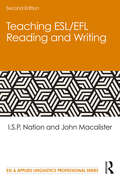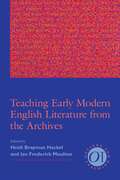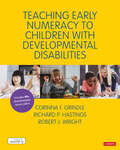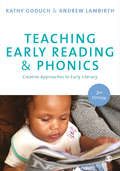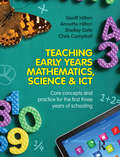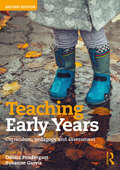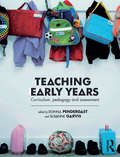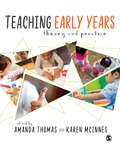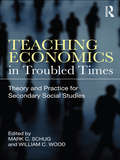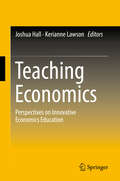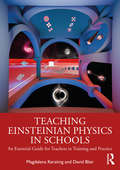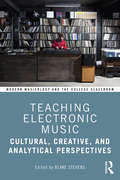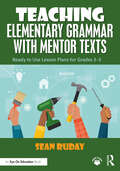- Table View
- List View
Teaching ESL/EFL Reading and Writing (ESL & Applied Linguistics Professional Series)
by I.S.P. NationUsing a framework based on principles of teaching and learning, this guide for teachers and teacher trainees provides a wealth of suggestions for helping learners at all levels of proficiency develop their reading and writing skills and fluency. By following these suggestions, which are organized around four strands – meaning-focused input, meaning-focused output, language-focused learning, and fluency development – teachers will be able to design and present a balanced program for their students. Teaching ESL/EFL Reading and Writing, and its companion text, Teaching ESL/EFL Listening and Speaking, are similar in format and the kinds of topics covered, but do not need to be used together. Drawing on research and theory in applied linguistics, their focus is strongly hands-on, featuring easily applied principles, a large number of useful teaching techniques, and guidelines for testing and monitoring, All Certificate, Diploma, Masters and Doctoral courses for teachers of English as a second or foreign language include a teaching methods component. The texts are designed for and have been field tested in such programs.
Teaching ESL/EFL Reading and Writing (ESL & Applied Linguistics Professional Series)
by John Macalister I.S.P. NationThe second edition of this bestselling text, Teaching ESL/EFL Reading and Writing, is a fully updated and expanded guide for teaching learners at all levels of proficiency how to develop their reading and writing skills and fluency. Practical and accessible, this book covers a diverse array of language teaching techniques suitable for all contexts. Updated with cutting-edge research and theory, the second edition is an essential and engaging text. Key insights and suggestions are organised around four strands – meaning-focused input, meaning-focused output, language-focused learning, and fluency development – to allow teachers to design and present a balanced programme for their students. Bringing together research and theory in applied linguistics and education, the text includes useful examples and practical strategies and features new topics related to technology, assessment, and genre. The second edition includes new tasks and further reading sections in every chapter. Teaching ESL/EFL Reading and Writing is designed for practising and pre-service teachers of all levels, and is ideal for certificate, diploma, masters, and doctoral courses in English as a second or foreign language.
Teaching Early Algebra through Example-Based Problem Solving: Insights from Chinese and U.S. Elementary Classrooms (Routledge Research in STEM Education)
by Meixia DingDrawing on rich classroom observations of educators teaching in China and the U.S., this book details an innovative and effective approach to teaching algebra at the elementary level, namely, "teaching through example-based problem solving" (TEPS). Recognizing young children’s particular cognitive and developmental capabilities, this book powerfully argues for the importance of infusing algebraic thinking into early grade mathematics teaching and illustrates how this has been achieved by teachers in U.S. and Chinese contexts. Documenting best practice and students’ responses to example-based instruction, the text demonstrates that this TEPS approach – which involves the use of worked examples, representations, and deep questions – helps students learn and master fundamental mathematical ideas, making it highly effective in developing algebraic readiness and mathematical understanding. This text will benefit post-graduate students, researchers, and academics in the fields of mathematics, STEM, and elementary education, as well as algebra research more broadly. Those interested in teacher education, classroom practice, and developmental and cognitive psychology will also find this volume of interest.
Teaching Early Modern English Literature from the Archives (Options for Teaching #36)
by Heidi Brayman Hackel and Ian Frederick MoultonThe availability of digital editions of early modern works brings a wealth of exciting archival and primary source materials into the classroom. But electronic archives can be overwhelming and hard to use, for teachers and students alike, and digitization can distort or omit information about texts. Teaching Early Modern English Literature from the Archives places traditional and electronic archives in conversation, outlines practical methods for incorporating them into the undergraduate and graduate curriculum, and addresses the theoretical issues involved in studying them. The volume discusses a range of physical and virtual archives from 1473 to 1700 that are useful in the teaching of early modern literature--both major sources and rich collections that are less known (including affordable or free options for those with limited institutional resources).Although the volume focuses on English literature and culture, essays discuss a wide range of comparative approaches involving Latin, French, Spanish, German, and early American texts and explain how to incorporate visual materials, ballads, domestic treatises, atlases, music, and historical documents into the teaching of literature.
Teaching Early Numeracy to Children with Developmental Disabilities (Math Recovery)
by Robert J Wright Corinna Grindle Professor Richard HastingsThis practical guide for teaching numeracy to children with a developmental disability is based on core concepts from the landmark Mathematics Recovery® text Teaching Number (aka &‘the green book&’) that have been adapted for children with developmental disabilities. It sets out key principles of teaching and learning underpinning an evidence-based teaching approach and provides clear guidance on how educators can plan and implement a structured teaching program so that every child can be given a positive experience in learning numeracy and achieve significant outcomes, maximizing their potential. The book is supported by a comprehensive set of online resources for use in the classroom, including 90+ lesson plans carefully tailored to provide sequenced learning experiences for children and school students who may need them most.
Teaching Early Numeracy to Children with Developmental Disabilities (Math Recovery)
by Robert J Wright Corinna Grindle Professor Richard HastingsThis practical guide for teaching numeracy to children with a developmental disability is based on core concepts from the landmark Mathematics Recovery® text Teaching Number (aka &‘the green book&’) that have been adapted for children with developmental disabilities. It sets out key principles of teaching and learning underpinning an evidence-based teaching approach and provides clear guidance on how educators can plan and implement a structured teaching program so that every child can be given a positive experience in learning numeracy and achieve significant outcomes, maximizing their potential. The book is supported by a comprehensive set of online resources for use in the classroom, including 90+ lesson plans carefully tailored to provide sequenced learning experiences for children and school students who may need them most.
Teaching Early Reading and Phonics
by Kathy Goouch Andrew LambirthTeaching Early Reading and Phonics: Creative Approaches to Early Literacy supports teachers using phonics in their teaching of early reading. The authors show how important it is to ensure that children acquire a wide range of reading strategies, while also setting out practical ’pointers’ which will enable teachers to translate the theory into effective practice. Readers will learn how to plan phonics within a rich, interactive and playful literacy pedagogy; how to construct relationships with the young readers in their classes and the texts around them; how to embed the teaching of phonics in carefully selected high quality materials – particularly in children’s literature. Written for practicing teachers, student teachers on initial teacher training courses at undergraduate and graduate levels, the book will also be useful for advisors working on continuing professional development.
Teaching Early Reading and Phonics: Creative Approaches to Early Literacy
by Kathy Goouch Andrew LambirthLearning to read is an exciting and vital part of every child’s development. The new edition of this book continues to provide trainees and teachers with a broad understanding of teaching reading and phonics, and equip them with the skills necessary to face the reality of the early years classroom in order to meet the needs of individual children. With vital information on constructing relationships with young readers, and how to plan phonics within a rich, interactive and playful literacy pedagogy, the second edition now includes: A brand new chapter on babies and early reading More information on language acquisition and how children learn A discussion of children with SEN An appreciation for the rise of digital technologies in relation to reading Whether you're training to become a teacher, or already working in the classroom this book is ideal for those who wish to embed the teaching of phonics into carefully selected high quality materials - particularly in children's literature.
Teaching Early Reading and Phonics: Creative Approaches to Early Literacy
by Kathy Goouch Andrew LambirthLearning to read is an exciting and vital part of every child’s development. The new edition of this book continues to provide trainees and teachers with a broad understanding of teaching reading and phonics, and equip them with the skills necessary to face the reality of the early years classroom in order to meet the needs of individual children. With vital information on constructing relationships with young readers, and how to plan phonics within a rich, interactive and playful literacy pedagogy, the second edition now includes: A brand new chapter on babies and early reading More information on language acquisition and how children learn A discussion of children with SEN An appreciation for the rise of digital technologies in relation to reading Whether you′re training to become a teacher, or already working in the classroom this book is ideal for those who wish to embed the teaching of phonics into carefully selected high quality materials - particularly in children′s literature.
Teaching Early Years Foundation Stage (Achieving QTS Series)
by Jo Basford and Elaine HodsonThe Early Years Foundation Stage (EYFS) came into force in September 2008 and established a framework for providing learning, development and care for children from birth to five. This book examines the EYFS within the context of Achieving QTS and is a core text for primary trainees covering this stage of children′s learning. It links the principles and commitments of the EYFS with the new standards for QTS while covering all required content. The book examines the continuous nature of learning from birth to five, the inter-relatedness between care, learning and development, and the importance of sensitive transitions.
Teaching Early Years Mathematics, Science and ICT: Core concepts and practice for the first three years of schooling
by Shelley Dole Chris Campbell Annette Hilton Geoff HiltonWhen young children first arrive at school, they generally know how to use a mobile phone and a tablet, and how to count, share and measure. They have a sense of wonder about the world around them. They expect to further interact with technology and to build and extend their mathematics and science knowledge.Teaching Early Years Mathematics, Science and ICT shows how teachers of children in their first three years of formal schooling can guide students in developing a sound understanding of the key concepts in mathematics and science in classroom and field activities. It shows how to select appropriate educational technology, and effectively and routinely integrate it into the learning experience, as part of students' wider classroom learning.Throughout, the authors make connections between children's out-of-school and in-school experiences, as well as connections across key learning areas. They provide real classroom examples of learning experiences which can be adapted for different year levels. A reflection template assists teachers in planning and successfully implementing teaching strategies to meet curriculum requirements.Teaching Early Years Mathematics, Science and ICT helps teachers bridge theory and practice in teaching children aged 5 to 8 years.
Teaching Early Years: Curriculum, Pedagogy, and Assessment
by Donna Pendergast Susanne GarvisEdited by Donna Pendergast and Susanne Garvis, this new edition of Teaching Early Years provides a comprehensive overview of and introduction to educating children from birth to eight years. Structured around the key priorities for early childhood education and care – curriculum, pedagogy, and assessment – this book supports readers to develop and enhance their knowledge and understanding of the essential theory, scholarship, and practical applications. This second edition has been thoroughly revised to reflect the significant innovation and development across the sector, ensuring that coverage of content, the latest research, and references to curricula and professional standards are up to date and relevant to today’s pre- and in-service educators. The new editionn includes a greater focus on a number of areas compared to the first edition, including: Sustainability education Health and nutrition Innovative and age-appropriate pedagogies Increased coverage of Aboriginal and Torres Strait Islander perspectives New understandings of the early years learner. Each chapter provides case studies, examples from practice, chapter summaries and reflection questions, encouraging the reader to engage more deeply with the key concepts and learning points. Bringing together leading scholars and practitioners, Teaching Early Years provides the specialist knowledge and preparation required for early years educators, in all learning environments, to deliver exceptional education and care to all children in the early years.
Teaching Early Years: Curriculum, pedagogy and assessment
by Donna Pendergast'This new early childhood text provides a comprehensive overview of early childhood education in Australia for children from birth to eight years. It reports on a wide variety of significant early childhood topics and is written in a style directed towards early childhood professionals.' - Kim Walters, President, Early Childhood Teachers AssociationThe early years of care and learning are recognised as crucial for ongoing educational success and future participation in society. Early childhood professionals need specialist preparation to understand and effectively support early years learners.Teaching Early Years offers a systematic, research-based introduction to educating children from birth to eight years. Leading educators identify the key priorities in early years education and cover developmental issues, curriculum, pedagogy and assessment. Each chapter concludes with questions that guide reflection of the concepts developed in the chapter.Written for early childhood education students, childcare workers and education leaders, Teaching Early Years is an essential resource for anyone involved in caring for and educating early years learners.
Teaching Early Years: Theory and Practice
by Amanda Thomas Karen McInnesThis textbook focuses on the main areas of teaching young children, covering the 3-7 years age range that spans the early years and primary phases. The majority of chapters are written by both an academic and practitioner, reflecting a genuine theory and practice approach, and this helps the reader to set theoretical discussion in the context of real practice. Key themes explored within the book include: - Play and playfulness in the curriculum - Child development in practice - Literacy development and subject pedagogy - Creativity and outdoor learning Packed full of learning features such as case studies, reflective questions and lesson plans, Teaching Early Years is an essential resource for both students and practitioners, and will enhance your knowledge of how young children think and learn.
Teaching Early Years: Theory and Practice
by Amanda Thomas Karen McInnesThis textbook focuses on the main areas of teaching young children, covering the 3-7 years age range that spans the early years and primary phases. The majority of chapters are written by both an academic and practitioner, reflecting a genuine theory and practice approach, and this helps the reader to set theoretical discussion in the context of real practice. Key themes explored within the book include: - Play and playfulness in the curriculum - Child development in practice - Literacy development and subject pedagogy - Creativity and outdoor learning Packed full of learning features such as case studies, reflective questions and lesson plans, Teaching Early Years is an essential resource for both students and practitioners, and will enhance your knowledge of how young children think and learn.
Teaching Economics in Troubled Times: Theory and Practice for Secondary Social Studies
by Mark C. SchugIn the Great Recession of 2007-2010, Americans watched their retirement savings erode and the value of their homes decline while the unemployment rate increased and GDP sank. New demands emerged for unprecedented government intervention into the economy. While these changes have a dramatic impact on society at large, they also have serious implications for the content and teaching of economics. Teaching Economics in a Time of Unprecedented Change is a one-stop collection that helps pre- and in-service social studies teachers to foster an understanding of classic content as well as recent economic developments. Part I offers clear and teachable overviews of the nature of today’s complex economic crisis and the corollary changes in teaching economics that flow from revising and updating long-held economic assumptions. Part II provides both detailed best practices for teaching economics in the social studies classroom and frameworks for teaching economics within different contexts including personal finance, entrepreneurship, and history. Part III concludes with effective strategies for teaching at the elementary and secondary school levels based on current research on economic education. From advice on what every economics teacher should know, to tips for best education practices, to investigations into what research tells us about teaching economics, this collection provides a wealth of contextual background and teaching ideas for today’s economics and social studies educators. Additional information and resources can be found at the authors’ website neweconteaching.com.
Teaching Economics: Perspectives on Innovative Economics Education
by Joshua Hall Kerianne LawsonThis book looks at a number of topics in economic education, presenting multiple perspectives from those in the field to anyone interested in teaching economics. Using anecdotes, classroom experiments and surveys, the contributing authors show that, with some different or new techniques, teaching economics can be more engaging for students and help them better retain what they learned. Chapters cover a wide range of approaches to teaching economics, from interactive approaches such as utilizing video games and Econ Beats, to more rigorous examinations of government policies, market outcomes and exploring case studies from specific courses. Many of the chapters incorporate game theory and provide worked out examples of games designed to help students with intuitive retention of the material, and these games can be replicated in any economics classroom. While the exercises are geared towards college-level economics students, instructors can draw inspiration for course lectures from the various approaches taken here and utilize them at any level of teaching. This book will be very useful to instructors in economics interested in bringing innovative teaching methods into the classroom.
Teaching Einsteinian Physics in Schools: An Essential Guide for Teachers in Training and Practice
by David Blair Magdalena KerstingIn our world today, scientists and technologists speak one language of reality. Everyone else, whether they be prime ministers, lawyers, or primary school teachers speak an outdated Newtonian language of reality. While Newton saw time and space as rigid and absolute, Einstein showed that time is relative – it depends on height and velocity – and that space can stretch and distort. The modern Einsteinian perspective represents a significant paradigm shift compared with the Newtonian paradigm that underpins most of the school education today. Research has shown that young learners quickly access and accept Einsteinian concepts and the modern language of reality. Students enjoy learning about curved space, photons, gravitational waves, and time dilation; often, they ask for more! A consistent education within the Einsteinian paradigm requires rethinking of science education across the entire school curriculum, and this is now attracting attention around the world. This book brings together a coherent set of chapters written by leading experts in the field of Einsteinian physics education. The book begins by exploring the fundamental concepts of space, time, light, and gravity and how teachers can introduce these topics at an early age. A radical change in the curriculum requires new learning instruments and innovative instructional approaches. Throughout the book, the authors emphasise and discuss evidence-based approaches to Einsteinian concepts, including computer- based tools, geometrical methods, models and analogies, and simplified mathematical treatments. Teaching Einsteinian Physics in Schools is designed as a resource for teacher education students, primary and secondary science teachers, and for anyone interested in a scientifically accurate description of physical reality at a level appropriate for school education.
Teaching Electromagnetics: Innovative Approaches and Pedagogical Strategies
by Karl F. Warnick Krishnasamy T. SelvanTeaching Electromagnetics: Innovative Approaches and Pedagogical Strategies is a guide for educators addressing course content and pedagogical methods primarily at the undergraduate level in electromagnetic theory and its applications. Topics include teaching methods, lab experiences and hands-on learning, and course structures that help teachers respond effectively to trends in learning styles and evolving engineering curricula. The book grapples with issues related to the recent worldwide shift to remote teaching. Each chapter begins with a high-level consideration of the topic, reviews previous work and publications, and gives the reader a broad picture of the topic before delving into details. Chapters include specific guidance for those who want to implement the methods and assessment results and evaluation of the effectiveness of the methods. Respecting the limited time available to the average teacher to try new methods, the chapters focus on why an instructor should adopt the methods proposed in it. Topics include virtual laboratories, computer-assisted learning, and MATLAB® tools. The authors also review flipped classrooms and online teaching methods that support remote teaching and learning. The end result should be an impact on the reader represented by improvements to his or her practical teaching methods and curricular approach to electromagnetics education. The book is intended for electrical engineering professors, students, lab instructors, and practicing engineers with an interest in teaching and learning. In summary, this book: Surveys methods and tools for teaching the foundations of wireless communications and electromagnetic theory Presents practical experience and best practices for topical coverage, course sequencing, and content Covers virtual laboratories, computer-assisted learning, and MATLAB tools Reviews flipped classroom and online teaching methods that support remote teaching and learning Helps instructors in RF systems, field theory, and wireless communications bring their teaching practice up to date Dr. Krishnasamy T. Selvan is Professor in the Department of Electronics & Communication Engineering, SSN College of Engineering, since June 2012. Dr. Karl F. Warnick is Professor in the Department of Electrical and Computer Engineering at BYU.
Teaching Electronic Music: Cultural, Creative, and Analytical Perspectives (Modern Musicology and the College Classroom)
by Blake StevensTeaching Electronic Music: Cultural, Creative, and Analytical Perspectives offers innovative and practical techniques for teaching electronic music in a wide range of classroom settings. Across a dozen essays, an array of contributors—including practitioners in musicology, art history, ethnomusicology, music theory, performance, and composition—reflect on the challenges of teaching electronic music, highlighting pedagogical strategies while addressing questions such as: What can instructors do to expand and diversify musical knowledge? Can the study of electronic music foster critical reflection on technology? What are the implications of a digital culture that allows so many to be producers of music? How can instructors engage students in creative experimentation with sound? Electronic music presents unique possibilities and challenges to instructors of music history courses, calling for careful attention to creative curricula, historiographies, repertoires, and practices. Teaching Electronic Music features practical models of instruction as well as paths for further inquiry, identifying untapped methodological directions with broad interest and wide applicability.
Teaching Elementary Grammar with Mentor Texts: Ready to Use Lesson Plans for Grades 3–5
by Sean RudayTeaching Elementary Grammar with Mentor Texts: Ready to Use Lesson Plans for Grades 3–5 contains detailed grammar lesson plans for teachers in grades three, four, and five. The lesson plans in this book incorporate the research-based best practices of grammar instruction and apply those practices to the teaching and learning of grammar instruction. They present grammatical concepts in the context of effective writing by using mentor texts. These mentor text examples, which students read from a writer’s perspective, deepen students’ metacognition of the importance of grammatical concepts and help them see the elements of grammar as tools for strong writing that authors use strategically to make their work as strong as possible. The book provides elementary school teachers with user-friendly lesson plans that they can easily use to put mentor text-based grammar instruction into action in their classrooms. These lesson plans feature published examples of grammatical concepts from contemporary children’s and middle-grade books, activities that help students connect their reading and writing experiences, and reflective activities that facilitate students’ metacognition of the importance of grammatical concepts. The thorough plans in this book will help teachers put the best practices of grammar instruction into action in concrete, practitioner-oriented ways.
Teaching Elementary Mathematics to Struggling Learners
by Mary E. Little Bradley S. WitzelPacked with effective instructional strategies, this book explores why certain K-5 students struggle with math and provides a framework for helping these learners succeed. The authors present empirically validated practices for supporting students with disabilities and others experiencing difficulties in specific areas of math, including problem solving, early numeracy, whole-number operations, fractions, geometry, and algebra. Concrete examples, easy-to-implement lesson-planning ideas, and connections to state standards, in particular the Common Core standards, enhance the book's utility. Also provided is invaluable guidance on planning and delivering multi-tiered instruction and intervention.
Teaching Elementary STEM Education: Unpacking Standards and Implementing Practice-Based Pedagogy
by Sherri CiancaThis textbook offers practical guidelines for integrating science, technology, engineering, and mathematics into the elementary classroom in the context of addressing real-world problems, and cultivating in students high-level thinking and problem-solving skills. Designed to equip teachers and future teachers with tools to create and implement standards-based STEM curriculum and cognitively demanding tasks, author Sherri Cianca offers hands-on, easily implemented strategies that foster student reasoning, autonomy, and humanity. This fresh approach to STEM teaching empowers teachers (preservice and inservice) and other leaders to better understand the standards and better design effective instructional practices. The chapters work together to advance teachers’ abilities to achieve mastery-level understanding of content, translate standards into student-friendly curriculum, and create a robust learning environment. Each chapter contains "probes" to uncover incomplete and inaccurate conceptions and to focus attention on key learning elements. Chapter summaries and "Reflect and Apply" sections reinforce professional development, and appendices expand on chapter content and provide rich examples of STEM units, curriculum, and assessment criteria. Dr. Cianca's vision is that teachers serve as well-equipped change agents that will empower their students to transfer STEM learning into applications that will impart a positive impact on our future world.
Teaching Elementary Social Studies: Principles and Applications
by James J. ZarrilloLearn how to meet the needs of the diverse students in your first classroom through this unique elementary social studies methods textbook. With a unifying theme of diversity, it emphasizes differentiated instruction and meeting the needs of all students, including special attention to English learners, children with mild learning disabilities, and gifted students Chapters on differentiated instruction (Chapter 4) and culturally-responsive teaching (Chapter 5) provide a strong foundation and context for the strategies and teaching tips that follow in later chapters. Reflecting the national trends toward standards-based instruction and greater utilization of technology, this book is a great resource for your first classroom and beyond Read and reference this text for comprehensive coverage including new chapters on teaching geography and the literacy and social studies connection, as well as existing chapters on the history and current status of social studies; lesson and unit planning; cooperative learning; critical thinking; technology; assessment; integrating the language arts, the visual arts, and the performing arts; citizenship education; history and geography; and the other social sciences. Finally, instructors and students have praised earlier editions of this book because of its pragmatic and accessible style.
Teaching Embodied: Cultural Practice in Japanese Preschools
by Joseph Tobin Akiko HayashiWhen we look beyond lesson planning and curricula--those explicit facets that comprise so much of our discussion about education--we remember that teaching is an inherently social activity, shaped by a rich array of implicit habits, comportments, and ways of communicating. This is as true in the United States as it is in Japan, where Akiko Hayashi and Joseph Tobin have long studied early education from a cross-cultural perspective. Taking readers inside the classrooms of Japanese preschools, Teaching Embodied explores the everyday, implicit behaviors that form a crucially important--but grossly understudied--aspect of educational practice. Akiko Hayashi and Joseph Tobin embed themselves in the classrooms of three different teachers at three different schools to examine how teachers act, think, and talk. Drawing on extended interviews, their own real-time observations, and hours of video footage, they focus on how teachers embody their lessons: how they use their hands to gesture, comfort, or discipli≠ how they direct their posture, gaze, or physical location to indicate degrees of attention; and how they use the tone of their voice to communicate empathy, frustration, disapproval, or enthusiasm. Comparing teachers across schools and over time, they offer an illuminating analysis of the gestures that comprise a total body language, something that, while hardly ever explicitly discussed, the teachers all share to a remarkable degree. Showcasing the tremendous importance of--and dearth of attention to--this body language, they offer a powerful new inroad into educational study and practice, a deeper understanding of how teaching actually works, no matter what culture or country it is being practiced in.

